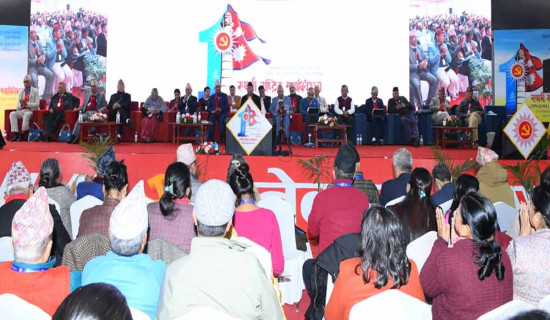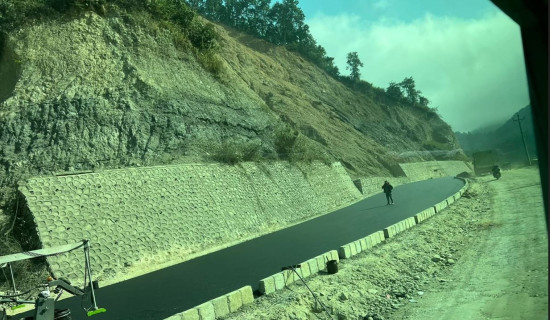- Monday, 15 December 2025
Need To Boost Nepal-Russia Cooperation
Former Soviet Union no longer exists now but the bridges it built on the East-West Highway in 1972 still serve their purpose. No one is sure how it would have helped if Russia had given the money for the 'capacity building' of recipient countries as other donor countries usually do. Today, Nepal and the Russian Federation mark the 68th anniversary of the establishment of diplomatic relations. In 1956, the then Union of Soviet Socialist Republics (USSR) had just reached its development pinnacle and was ready to fly into space after 40 years of the October Revolution. In the same year, the two nations opened their diplomatic ties, which have since expanded into diverse fields of mutual cooperation and development.
It should be considered a mere coincidence that in October 1957, the Soviet Union launched the first artificial satellite into space. From that year, the Soviet government began providing scholarships to Nepali students. Since then, thousands of specialists have graduated from Soviet and Russian universities and are now working as engineers, doctors, agronomists, and in other professions. In addition to producing highly skilled human resources, it has also provided significant development assistance in the establishment of vital infrastructure.
Modernisation process
Russian cooperation in building physical and industrial infrastructure contributed to accelerating the modernisation process in Nepal. The former USSR provided assistance to Nepal for the establishment of the country's pioneering Kanti Hospital in 1963, Panauti Hydro-electric power station in 1965, the Janakpur Cigarette Factory and Agricultural Tools Factory in 1968, the Birgunj Sugar Mill in 1964, and the Resin and Turpentine Plant in western Nepal in 1987, among others. With the adoption of the liberalisation policy, almost all key industries gifted as tokens of love from the Soviet people have remained shut since 2003 and are now limited to history.
The Soviet Union was the first country to support the call of the late King Mahendra to the international community to help Nepal build the East-West Highway. When there was a devastating earthquake in Nepal in April 2015, Ivan Goncharov, a Soviet engineer who was involved in the construction of the East-West Highway in the 1970s, cried a lot. He once enjoyed walking around the ancient palaces, temples, seeing artistically carved tundals (small carved wood blocks) and supernatural brick houses in the narrow streets of this ancient country. He could not sit without taking a pen to express his deep sympathy for such a good country and its good and friendly people. Reminiscing about the beautiful past, he writes:
“...... The green ridges of the Himalayan arms stretching from east to west, seen from the small window of the descending airplane, made the first impression of Nepal on my mind. Due to the establishment of diplomatic relations between the Soviet Union and Nepal, we Soviet engineers had the opportunity to work in this kingdom located at the farthest corner of the world. The group of local village boys at the project site was truly outstanding. It was easy to work with them. Even though poverty is widespread, Nepal is a country of happy people. All are hardworking, open-hearted, and cheerful."
Goncharov recalls the inauguration of the East-West Highway: "In the month of December 1972, traffic was operated on the Simra-Janakpur road. King Birendra of Nepal, Soviet ambassador Boris Kirnasovsky, chief engineer of the construction project Pavel Kravchov, and all the Nepalis and Russians involved in the construction took part in this inauguration programmes. Nepalis congratulated us by showering flowers all over the road, garlanded us, and also gave us some gifts."
Bilateral ties between Russia and Nepal slowed down when both countries entered a phase of political transition during the 1990s. A cooperation agreement between the Nepalese and Russian Chambers of Commerce was signed in 2011. Russian expertise in the energy sector could be of tremendous importance for Nepal, particularly in cooperation on hydro-power plants. The influx of Russian tourists is increasing, with Lumbini and the Himalayas becoming prominent attractions for them. The Russian Federation extended support for the relief of victims in the aftermath of the devastating earthquakes of 2015. A Russian Buddhist Temple is being built in Lumbini. Russia has continued providing scholarships to Nepali students, with the full scholarship quota now increased from 50 to 250.
Russian proposals
On May 4, 2023, the Russian Embassy sent a letter to Nepal asking for detailed proposals for 13 different projects, including the Pokhara-Parbat-Ridi Road, a Children's Cancer Hospital, the East-West Railway, scholarships, and more. However, the Russian side stated, "We've not received any formal request from Nepal so far." Similarly, in a meeting with the Minister of Physical Infrastructure and Transport on August 21, 2023, Russia requested a proposal for the Kathmandu Metro project.
During the Cold War, Nepal adhered to the principle of non-alignment. Russia respected the non-aligned foreign policy that Nepal had been pursuing for a long time. The Soviet Union was a country that selflessly helped Nepal in the industrialisation of the agricultural sector. No matter how many changes occur on the world stage, history will never forget the contribution of the Soviet Union to the development of Nepal. On this significant day, we are grateful to the Russian government and people for their continuous support to Nepal.
Long live Nepal-Russia friendship!
(Shrestha is a graduate of Soviet University, 1991)
















